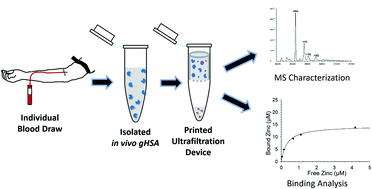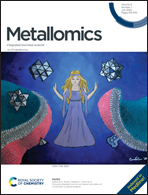A novel 3D-printed centrifugal ultrafiltration method reveals in vivo glycation of human serum albumin decreases its binding affinity for zinc†
Abstract
Plasma proteins are covalently modified in vivo by the high-glucose conditions in the bloodstreams of people with diabetes, resulting in changes to both structure and function. Human Serum Albumin (HSA) functions as a carrier-protein in the bloodstream, binding various ligands and tightly regulating their bioavailability. HSA is known to react with glucose via the Maillard reaction, causing adverse effects on its ability to bind and deliver certain ligands, such as metals. Here, the binding between in vivo glycated HSA and zinc (Zn2+) was determined using a novel centrifugal ultrafiltration method that was developed using a 3D-printed device. This method is rapid (90 minutes), capable of high-throughput measurements (24 samples), low-cost (<$1.00 USD per device) and requires lower sample volumes (200 μL) compared to other binding techniques. This device was used to determine an equilibrium dissociation constant between Zn2+ and a commercially obtained normal HSA (nHSA) with a glycation level of 11.5% (Kd = 2.1 (±0.5) × 10−7 M). A glycated fraction of the nHSA sample was enriched (gHSA, 65.5%) and isolated using boronate-affinity chromatography, and found to have a 2.3-fold decrease in Zn2+ binding-affinity (Kd = 4.8 (±0.8) × 10−7 M) when compared to the nHSA sample. The level of glycation of HSA in control plasma (13.0% ± 0.8, n = 3 donors) and plasma from people with diabetes (26.9% ± 6.6, n = 5 donors) was assessed using mass spectrometry. Furthermore, HSA was isolated from plasma obtained in-house from a person with type 1 diabetes and found to have a glycation level of 24.1% and Kd = 3.3 (± 0.5) × 10−7 M for Zn2+, revealing a 1.5-fold decrease in binding affinity compared to nHSA. These findings suggest that increased levels of glycated HSA result in reduced binding to Zn2+, which may have implications in complications associated with diabetes.



 Please wait while we load your content...
Please wait while we load your content...